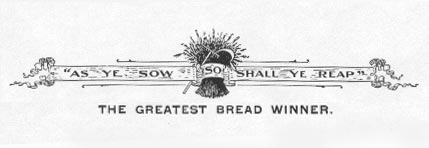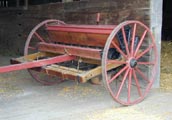April 2001

As Ye Sow So Shall Ye Reap
"In the Farmers' Favorite Plain Drill we offer the best machine for the purpose that has ever been produced, and believe we can prove it to be better made, of better material, better finished, better balance, and capable of sowing a greater range of work easier and better under all circumstances than any other."
Bickford & Huffman Co. Catalogue, 1896.
Lyman Bickford and Henry Huffman founded what became The Bickford & Huffman Co. in 1842. By the 1870s their small company in Macedon, NY sold one of nation's most effective mechanical planters. The mechanization that took place on American farms with machinery such as horsedrawn grain drills, reapers, and threshing machines allowed American farmers to increase their field size and efficiently harvest small grain crops such as wheat, oats and barley. If properly planted, these crops grow densely, and farmers did not need to remove weeds. But if the seeds were dropped inconsistently, then weeds would take up space in the field and reduce the harvest - truly how well you sowed your crop determined the quantity you would reap. To comply with their customers beliefs, and to confirm their machines superiority, the Bickford & Huffman Co. emblazoned their grain drills with the phrase "As Ye Sow So Shall Ye Reap," along with the name "The Farmers' Favorite."
From the 1840s into the 1880s, the Midwest served as America's breadbasket. Ohio farmers ranked top in the nation in wheat production in 1840 with 16.5 million bushels. That is almost 1,000,000,000 pounds of wheat! Farmers such as Benjamin Firestone in Columbia county, Ohio planted winter wheat in the fall as a cash crop, and oats in the spring to use as horse feed. In 1880, he planted 8 acres of wheat and 10 acres of oats. Like all farmers, his expectations were heightened as he planted his crops and hoped for a bountiful harvest. Like many farmers, he probably abided by the rule "As Ye Sow, So Shall Ye Reap." By the late 1800s, wheat production shifted to Kansas, Nebraska, and the Dakotas.

The Drill at Greenfield Village

Detail
|
|
You can see a Bickford & Huffman grain drill in use at Greenfield Village as the hands at Firestone Farm prepare and plant the fields. The drill drop seeds just a few inches apart, and the wheat or oats will sprout and spread making a lush field of grain. By the middle of June to early July, the grain will be ready to harvest where it will be stored until we thresh it during our Fall Harvest Festival. This drill, though more than 100 years old, continues to sow the hopes of our farmers and demonstrate the innovations in American agriculture.
Today, farmers still plant using grain drills. Tractor-drawn machines pull grain drills that are as wide as 30 feet. Farmers still rely on a good stand of grain to help control weeds, but also spray herbicide to kill unwanted plants in the field. Some people worry that the use of these chemicals threaten our environment. Others argue that when used in moderation these chemicals are safe. Though we are reaping bountiful harvests our farming practices may result in unintended problems, and we may not know all that we are harvesting.
-- Leo E. Landis, Curator of Agriculture & Rural Life
|

